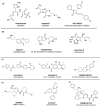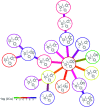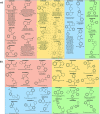Exploring the chemical space and the bioactivity profile of lactams: a chemoinformatic study
- PMID: 35528563
- PMCID: PMC9070607
- DOI: 10.1039/c9ra04841c
Exploring the chemical space and the bioactivity profile of lactams: a chemoinformatic study
Abstract
Lactams are a class of compounds important for drug design, due to their great variety of potential therapeutic applications, spanning cancer, diabetes, and infectious diseases. So far, the biological profile and chemical diversity of lactams have not been characterized in a systematic and detailed manner. In this work, we report the chemoinformatic analysis of beta-, gamma-, delta- and epsilon-lactams present in databases of approved drugs, natural products, and bioactive compounds from the large public database ChEMBL. We identified the main biological targets in which the lactams have been evaluated according to their chemical classification. We also identified the most frequent scaffolds and those that can be prioritized in chemical synthesis, since they are scaffolds with potential biological activity but with few reported analogs. Results of the biological and chemoinformatic analysis of lactams indicate that spiro- and bridged-lactams belong to classes with the lowest number of compounds and unique scaffolds, and some showing activity against specific targets. Information obtained from this analysis allows focusing the design of new chemical structures in less explored spaces and with increased possibilities of success.
This journal is © The Royal Society of Chemistry.
Conflict of interest statement
The authors declare that they do not have any conflict of interest related to this manuscript.
Figures









Similar articles
-
Chemical Space and Diversity of the NuBBE Database: A Chemoinformatic Characterization.J Chem Inf Model. 2019 Jan 28;59(1):74-85. doi: 10.1021/acs.jcim.8b00619. Epub 2018 Dec 17. J Chem Inf Model. 2019. PMID: 30508485
-
Computational-aided design of a library of lactams through a diversity-oriented synthesis strategy.Bioorg Med Chem. 2020 Jun 15;28(12):115539. doi: 10.1016/j.bmc.2020.115539. Epub 2020 May 4. Bioorg Med Chem. 2020. PMID: 32503698
-
Trifluoromethylated lactams: promising small molecules in the search for effective drugs.Chem Commun (Camb). 2025 Jan 9;61(5):785-802. doi: 10.1039/d4cc05324a. Chem Commun (Camb). 2025. PMID: 39659174 Review.
-
Spiro-Lactams as Novel Antimicrobial Agents.Curr Top Med Chem. 2020;20(2):140-152. doi: 10.2174/1568026619666191105110049. Curr Top Med Chem. 2020. PMID: 31702503
-
Principle and design of pseudo-natural products.Nat Chem. 2020 Mar;12(3):227-235. doi: 10.1038/s41557-019-0411-x. Epub 2020 Feb 3. Nat Chem. 2020. PMID: 32015480 Review.
Cited by
-
Preparation of Antiproliferative Terpene-Alkaloid Hybrids by Free Radical-Mediated Modification of ent-Kauranic Derivatives.Molecules. 2021 Jul 28;26(15):4549. doi: 10.3390/molecules26154549. Molecules. 2021. PMID: 34361708 Free PMC article.
-
Simultaneous Enantiodivergent Synthesis of Diverse Lactones and Lactams via Sequential One-Pot Enzymatic Kinetic Resolution-Ring-Closing Metathesis Reactions.Molecules. 2022 Nov 9;27(22):7696. doi: 10.3390/molecules27227696. Molecules. 2022. PMID: 36431796 Free PMC article.
-
Enantioselective Synthesis of γ-Lactams by Lewis Base Catalyzed Sulfenoamidation of Alkenes.Org Lett. 2020 Apr 3;22(7):2501-2505. doi: 10.1021/acs.orglett.9b04347. Epub 2019 Dec 20. Org Lett. 2020. PMID: 31858805 Free PMC article.
-
Microwave-Assisted Atom Transfer Radical Cyclization in the Synthesis of 3,3-Dichloro-γ- and δ-Lactams from N-Alkenyl-Tethered Trichloroacetamides Catalyzed by RuCl2(PPh3)3 and Their Cytotoxic Evaluation.Molecules. 2024 Apr 28;29(9):2035. doi: 10.3390/molecules29092035. Molecules. 2024. PMID: 38731527 Free PMC article.
-
A New, Convenient Way to Fully Substituted α,β-Unsaturated γ-Hydroxy Butyrolactams.Int J Mol Sci. 2023 Jun 16;24(12):10213. doi: 10.3390/ijms241210213. Int J Mol Sci. 2023. PMID: 37373361 Free PMC article.
References
LinkOut - more resources
Full Text Sources

